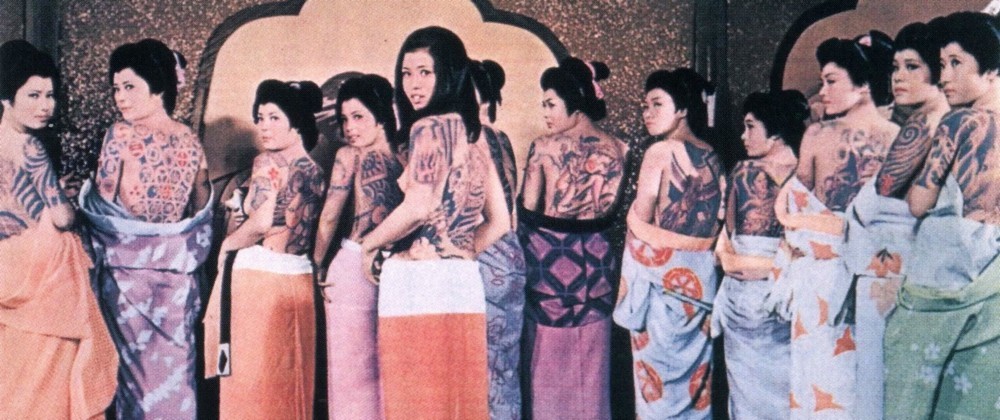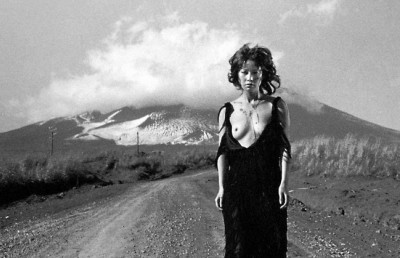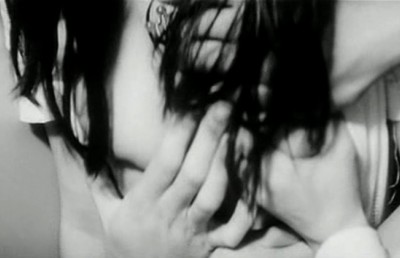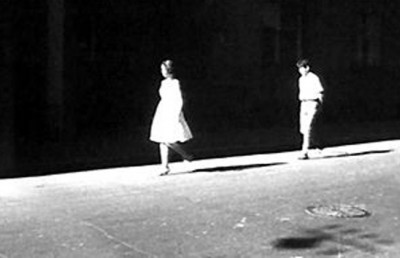Teruo Ishii, the outcast
Teruo Ishii at the Udine «Far East Film Festival»

“Surely there are limits, but within these limits one can do whatever he pleases,” said specialist Kato Akira about the roman porno genre. The same can be said about those hybrids in which submission and bondage give way to sheer violence and torture: thus, the jidai-geki (period films) produced by Toei and set during the Tokugawa dynasty can be considered a peculiar form of splatter movie. It is mainly due to these ero-guro (erotic-grotesque) flicks – precisely, the so-called Joys of Torture series – that the name Ishii Teruo is not new to Japanese cinema devotees, with such titles as Tokugawa Onna Keibatsushi (Tokugawa History of Women Punishment a.k.a. Criminal Women, 1968) and Tokugawa Irezumi Shi Seme Jigoku (Tokugawa Tattoo History: Torture Hell, 1969). Some will also remember his early sci-fi movies, such as the Super Giants series in the late Fifties. But, actually, Ishii’s body of work has been largely overlooked by Western critics, partly due to the scarce availability of his films outside of Japan, partly because Ishii himself was considered a minor, if not forgettable, director.
Thanks to the V Edition of the Udine «Far East Film Festival» (April 24th – May 1st), which dedicated a six films retrospective to the octogenarian director (known in his native Japan as «The King of Cult»), this prejudice can now be swept away. Ishii is an eclectic, talented filmmaker whose oeuvre is not only significant in itself, but also as a mirror of what Japanese film industry was like in the ’60s and ’70s. In the course of a fifty-year career (he debuted in 1957 with a boxing film called Ring no Oja: Eiko no Sekai) which includes 83 feature films, Ishii has directed Martial Arts flicks, science fiction, horror, erotic, and film noir. To peruse his filmography means to jump from genre to genre, in a production system dedicated to serialization with assembly-line rhythms. Ishii never had problems adjusting: he directed six episodes of the Super Giants series, eight of the Tokugawa cycle, and four of the noir Line films in the early ‘60s. He was fast and efficient, the kind of filmmaker studios (Shin Toho, Toei, Shochiku) don’t let go… and the one critics (often too busy searching for Auteurs and Art) often despise – that is if they even bother to watch his films. As Mark Schilling points out, “Ishii did not fall into the usual cult hero categories, such as self-destructive rebel (Suzuki), bold innovator (Fukasaku) or neglected genius (Kato)” 1 .
Not that Ishii – this shy, calm, little man who looked pleasantly surprised by the public’s attention as he climbed on stage for interviews – ever cared. He could have refused, as when Toei asked him to direct the follow-up to the wonderful Abashiri Bangaichi (The Man From Abashiri Jail, 1965), a prison movie openly inspired by Stanley Kramer’s The Defiant Ones. Instead, he ended up directing ten instalments of the series between 1964 and 1967, before leaving the job to other directors (the Abashiri Bangaichi series features a total of 18 episodes, the last entry dating 1972). The Man From Abashiri Jail, starring Takakura Ken and Tamba Tetsuro, is set in the snowy Hokkaido isle, and was made under difficult circumstances, according to Ishii:
We were using every room in the place and some had no heaters – it was really tough. It was so cold that when you woke up early in the morning you could see deer standing by the dorm, unable to move because of the snow. We brought cars up to the dorm and left them there overnight, but in the morning they wouldn’t start because the engines were frozen. I thought, “I’ve come to some kind of ice box.” 2
The film’s got a solid structure, in which flashbacks punctuate narration without compromising continuity; two strong, charismatic leads; a theme song (sung by Takakura) which became enormously popular in Japan; and several outstanding action sequences. The final chase scene, in which the two convicts escape down a mountain on a railroad handcar, is particularly memorable, and brings to mind Konchalovskij’s Runaway Train (which in turn was based on a Kurosawa Akira script).
Another pleasant surprise was represented by Sexy Chitai (Sexy Line, 1961), the last instalment in the Line series. It’s a lively portrait of the Tokyo underworld, populated by hookers, johns, crooks and cops and shot in cinéma-verité style: Ishii and cameraman Yoshida Noboru went out into the streets of Ginza and Asakusa districts, shooting without any permission whatsoever in order to capture real-life atmosphere. The result is sharp, witty and contagious, with an urgency that recalls the films of Joseph H. Lewis and Samuel Fuller (the heroine is a pickpocket, just like Richard Widmark in Pickup on South Street) and a great jazzy score by Hiraoka Seiji. Porno Jidaigeki: Bohachi Bushido (Porno Period Drama: Bohachi Code of Honor, 1973), on the other hand, is a late ero-guro full of unreal colors (as in the opening sequence, were the hero battles dozen of enemies on a bridge in the twilight, surrounded by flaming reds and greens) and wall-to-wall sex. Compared to the Tokugawa instalments, it is less focused on the “educational” aspects than on the main character, a self-destructive, nihilistic ronin played with gusto by Tamba Tetsuro.
Gensenkan Shujin (Master of the Gensenkan Inn, 1993), Ishii’s comeback after a fourteen year absence from the screen, is based upon Tsuge Yoshiharu’s mangas, as is Nejishiki (Wind-Up Type, 1998). The former, a four-segment anthology, intertwines the framing story (about a down-on-his-luck manga artist who resembles the young Tsuge) with episodes from his own creations. The third and title segment, an eerie, erotic ghost story, is set in a town whose inhabitants are grotesquely wrinkled old women and tells of the love affair between a stranger and the mute mistress of the local inn. Unexpectedly, after a first half dominated by surreal humour and loony characters, Ishii throws in a harrowing rape/seduction scene which harks back to the old days of roman porno. The same uneasy blend of genres can be found in Wind-Up Type, which starts with a vision of hell not far from Hieronymus Bosch and follows with more politically incorrect humour (including an exhilarating urine gag). The final third is an oneiric journey into the realms of subconscious that boldly mixes symbolism and such surreal imagery as a vein protruding from the protagonist’s arm which is then closed by putting a tap on it, a patently fake train model travelling on a desolate landscape, and a sea cruiser straight out of a Fellini film. Other references: David Lynch, Ken Russell, and Jan Svankmajer. The result is simply amazing.
What all these films have in common is Ishii’s peculiar sensibility towards eroticism, even in its most unusual ways. According to Mark Schilling:
…a closer look at his films often reveals (…) that, far from simple-mindedly revelling in his on-screen outrages, Ishii is well aware of their moral character, as judged by the standards of the society at large. That he does not come down four-square for these standards, that he, in fact, has sympathy for his various devils and takes obvious relish in portraying them and their nefarious works on screen, is very much in line with the “ero-guro” tradition. It is also very much out of step with not only Western PC attitudes, but the desire of many modern Japanese (including ones at Ishii’s former studio, Toei) to present only the positive sides of their culture to the outside world. 3
Ishii means genre cinema, but it bears the germs of diversity. His antiheroes are solitary outcasts, such as ronin Tamba Tetsuro in Porno Period Drama: Bohachi Bushido, or the protagonist of Edogawa Rampo Taizen Kyofu Kikei Ningen (Edogawa Rampo’s Horror of the Malformed Men, 1969), who hides on an island where he reigns over a community of freaks. Based on Edogawa Rampo stories, the film has gained cult status in Japan, but has never been released on VHS or DVD because of its disturbing theme, even though all the “freaks” that appear in the picture are actors in makeup. The film begins in an asylum and turns into a detective story about halfway through. When we finally get on the island, Ishii relies on flashbacks to tell the story of his misanthropic madman (played by Hijikata Tatsumi, the founding father of the Butoh school of dance) and ends the picture with a bang, as bodies explode and limbs fly in the sky as if they were fireworks. Hijikata, as Schilling notes:
“…is the film’s most impressive “special effect”. With his scraggly beard, long, tangled hair and flowing robe, he has the look of a mad prophet of an unholy faith. Moving across the rocks of his island kingdom with a crab-like resolve and creepy, angular grace, he obscures the boundary between the real ad the unreal, the human and inhuman”. 4
Ishii may have been right when, in his introduction to the film, said he would be happy if three or four people in the audience liked the film. Horror of the Malformed Men is preposterous and full of mind-blowing trashy moments, but it is so bold in its excesses to deserve a place in the annals of teratologic cinema. As Schilling puts it:
The inhabitants of Ishii’s “ero-guro” world may be very much his creations, but they have a long, surprisingly distinguished lineage. Today their descendants can be found flourishing in manga, animation and the film of Ishii’s juniors, particularly the work of Miike Takashi, Ishii’s taboo-shattering spiritual heir. 5
Notes
- Mark Schilling, Ishii Teruo: The King of Cult, «Nickelodeon» n. 104-105, Centro Espressioni Cinematografiche/Cineteca del Friuli, Udine, April 2003, p. 81. ↩
- Mark Schilling, Ishii Teruo, leader of the gang, «Nickelodeon» n. 104-105, p. 93. ↩
- The King of Cult, p. 83. ↩
- Mark Schilling, Horror of the Malformed Men review, «Nickelodeon» n. 104-105, p. 112. ↩
- The King of Cult, p.83. ↩














